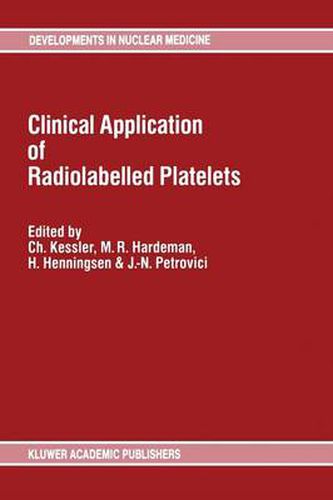Readings Newsletter
Become a Readings Member to make your shopping experience even easier.
Sign in or sign up for free!
You’re not far away from qualifying for FREE standard shipping within Australia
You’ve qualified for FREE standard shipping within Australia
The cart is loading…






This title is printed to order. This book may have been self-published. If so, we cannot guarantee the quality of the content. In the main most books will have gone through the editing process however some may not. We therefore suggest that you be aware of this before ordering this book. If in doubt check either the author or publisher’s details as we are unable to accept any returns unless they are faulty. Please contact us if you have any questions.
AIMS OF THE COLOGNE-SYMPOSIUM ON RADIOLABELLED PLATELETS In 1976, M. Thakur et al (1) were the first to publish a paper concerning the in vivo thrombus detection with 111- In-labelled platelets. Previous attempts at scintigraphic thrombus localisation had been disappointing because of the unspecific binding of a number of the isotopes used, as well as the poor labelling efficiency or an insufficient low gamma-emitting property. Because of its physical characteristics (2.8 days half-life, 94% gamma emission) 111 Indium turned out to be the best isotope for platelet kinetic studies as well as for the measurement of platelet incorporation by Thrombi to be used up until now. The lipophile complexes of Ill-In (8-hydroxyquinoline, acetylacetone, tropolone) diffuse passively into the platelets without altering the function or the life span of the platelets. This advantage has let to an increase in the clinical applications of 1211-In labelled platelets. Today, radiolabelled platelets are used for thrombus detection in several different medical areas such as cardiology, nephrology. angiology or neurology. Even though many scientists and hospital doctors now routinely use radiolabelled platelet as a diagnostic tool, there is as yet not a standardized labelling method. In addition to this, there are neither standardized image procedures for the different clinical applications nor an agreement about specificity and sensitivity of the method. In 1983, a symposium on Radiolabelled Cellular Blood Elements was organized by M.Thakur, M.R.Hardeman and M.D.
$9.00 standard shipping within Australia
FREE standard shipping within Australia for orders over $100.00
Express & International shipping calculated at checkout
This title is printed to order. This book may have been self-published. If so, we cannot guarantee the quality of the content. In the main most books will have gone through the editing process however some may not. We therefore suggest that you be aware of this before ordering this book. If in doubt check either the author or publisher’s details as we are unable to accept any returns unless they are faulty. Please contact us if you have any questions.
AIMS OF THE COLOGNE-SYMPOSIUM ON RADIOLABELLED PLATELETS In 1976, M. Thakur et al (1) were the first to publish a paper concerning the in vivo thrombus detection with 111- In-labelled platelets. Previous attempts at scintigraphic thrombus localisation had been disappointing because of the unspecific binding of a number of the isotopes used, as well as the poor labelling efficiency or an insufficient low gamma-emitting property. Because of its physical characteristics (2.8 days half-life, 94% gamma emission) 111 Indium turned out to be the best isotope for platelet kinetic studies as well as for the measurement of platelet incorporation by Thrombi to be used up until now. The lipophile complexes of Ill-In (8-hydroxyquinoline, acetylacetone, tropolone) diffuse passively into the platelets without altering the function or the life span of the platelets. This advantage has let to an increase in the clinical applications of 1211-In labelled platelets. Today, radiolabelled platelets are used for thrombus detection in several different medical areas such as cardiology, nephrology. angiology or neurology. Even though many scientists and hospital doctors now routinely use radiolabelled platelet as a diagnostic tool, there is as yet not a standardized labelling method. In addition to this, there are neither standardized image procedures for the different clinical applications nor an agreement about specificity and sensitivity of the method. In 1983, a symposium on Radiolabelled Cellular Blood Elements was organized by M.Thakur, M.R.Hardeman and M.D.